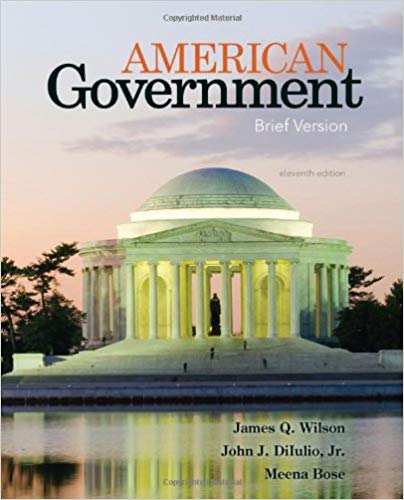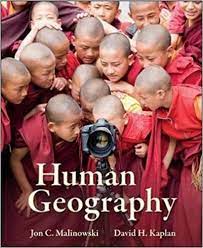Description
Test Bank For American Government Brief Version 11th Edition by James Q. Wilson
CHAPTER 3: Civil Liberties MULTIPLE CHOICE
1.The amendment that is probably the most important in terms of having the Bill of Rights apply to the states is the
|
a. |
Tenth Amendment. |
|
b. |
Twelfth Amendment. |
|
c. |
Fourteenth Amendment. |
|
d. |
Twentieth Amendment. |
|
e. |
Twenty-second Amendment. |
ANS: C REF: 39 NOT: Factual
2.The Fourteenth Amendment provides for
|
a. |
equal protection only. |
|
b. |
due process and equal protection. |
|
c. |
states’ rights. |
|
d. |
due process only. |
|
e. |
habeas corpus and the elimination of ex post facto laws. |
ANS: B REF: 40 NOT: Factual
3.The process of incorporation means that
|
a. |
private individuals are not required to obey the Bill of Rights. |
|
b. |
some provisions of the Bill of Rights also govern the states. |
|
c. |
the southern states were absorbed back into the Union after the Civil War. |
|
d. |
the provisions of the Bill of Rights apply to the federal government but not to the states. |
|
e. |
the original amendments to the Constitution are applicable to state governments and all others to the federal government. |
ANS: B REF: 40 NOT: Conceptual
4.In general, all of the rights in the Bill of Rights now apply to the states, except for the
|
a. |
First and Second Amendments. |
|
b. |
Second and Fourth Amendments. |
|
c. |
Third and Fifth Amendments. |
|
d. |
Third and Fourth Amendments. |
|
e. |
Fourth and Fifth Amendments. |
ANS: C REF: 40 NOT: Factual
5.In 2010, the Supreme Court ruled that the Second Amendment means one has a “right” to _________ for self-protection.
|
a. |
“conceal and carry” |
|
b. |
keep a handgun |
|
c. |
refuse to register weapons |
|
d. |
purchase high caliber fully automatic weaponry |
|
e. |
None of the above is true. |
ANS: B REF: 40 NOT: Factual
6.The fact that Americans go to court to sue one another indicates that
|
a. |
the Constitution is a flawed document that does not protect enough rights. |
|
b. |
a second civil war could easily occur in the United States over racial issues. |
|
c. |
the people do not trust the national government to treat them fairly. |
|
d. |
rights are in conflict. |
|
e. |
power is more centralized in presidential systems. |
ANS: D REF: 41 NOT: Conceptual
7.In the 1950s, the State of New York banned a film that dealt with the topic of
|
a. |
adultery. |
|
b. |
drugs. |
|
c. |
homosexuality. |
|
d. |
murder. |
|
e. |
kidnapping. |
ANS: A REF: 41 NOT: Factual
8.Which of the following has the Supreme Court considered to be “speech” deserving constitutional protection?
|
a. |
Burning draft registration certificates |
|
b. |
Nude dancing |
|
c. |
Burning the American flag |
|
d. |
Sleeping overnight in national parks |
|
e. |
Both options B and C are true. |
ANS: E REF: 41 NOT: Factual
9.The ban on unreasonable searches and seizures can be found in the
|
a. |
First Amendment. |
|
b. |
Second Amendment. |
|
c. |
Fourth Amendment. |
|
d. |
Fifth Amendment. |
|
e. |
Tenth Amendment. |
ANS: C REF: 42 NOT: Factual
10.The ban on double jeopardy can be found in the
|
a. |
First Amendment. |
|
b. |
Second Amendment. |
|
c. |
Fourth Amendment. |
|
d. |
Fifth Amendment. |
|
e. |
Tenth Amendment. |
ANS: D REF: 42 NOT: Factual
11.A bill of attainder
|
a. |
declares a person innocent, without trial, or a crime. |
|
b. |
pardons a person of an offense before trial. |
|
c. |
removes any all records of a criminal offense. |
|
d. |
declares a person, without trial, guilty of a crime. |
|
e. |
None of the above is true. |
ANS: D REF: 42 NOT: Factual
12.An ex post facto law declares an act “illegal”
|
a. |
before the fact. |
|
b. |
after the fact. |
|
c. |
without reference to facts. |
|
d. |
if the facts are merely circumstantial. |
|
e. |
if the facts are compelling and without contradiction. |
ANS: B REF: 42 NOT: Factual
13.The right of free expression, although not absolute, enjoys a higher status than the other rights granted by the Constitution. This is known as the doctrine of
|
a. |
prior restraint. |
|
b. |
inevitable discovery. |
|
c. |
neutrality and clarity. |
|
d. |
least means. |
|
e. |
preferred position. |
ANS: E REF: 42 NOT: Conceptual
14.All the following are addressed in the First Amendment except
|
a. |
free exercise of religion. |
|
b. |
due process of law. |
|
c. |
establishment of religion. |
|
d. |
freedom of assembly. |
|
e. |
freedom of the press. |
ANS: B REF: 42 NOT: Factual
15.In free expression, neutrality refers to which of the following?
|
a. |
The utterance of inflammatory, dangerous statements |
|
b. |
The absolute nature and unconditional status of speech |
|
c. |
The restriction of press coverage |
|
d. |
The government not favoring one group over another |
|
e. |
Political speech not being symbolic |
ANS: D REF: 43 NOT: Conceptual
16.The Supreme Court’s landmark decision in New York Times v. Sullivan focused on
|
a. |
fundamental liberties. |
|
b. |
clear and present danger. |
|
c. |
libel. |
|
d. |
obscenity. |
|
e. |
flag burning. |
ANS: C REF: 43 NOT: Factual
17.The Supreme Court’s landmark decision in Miller v. California focused on
|
a. |
fundamental liberties. |
|
b. |
clear and present danger. |
|
c. |
libel. |
|
d. |
obscenity. |
|
e. |
flag burning. |
ANS: D REF: 43 NOT: Factual
18.The Supreme Court’s landmark decision in Texas v. Johnson focused on
|
a. |
fundamental liberties. |
|
b. |
clear and present danger. |
|
c. |
libel. |
|
d. |
obscenity. |
|
e. |
flag burning. |
ANS: E REF: 43 NOT: Factual
19.In general, you may make false and defamatory statements about public officials so long as you lack
|
a. |
actual malice. |
|
b. |
presumed competence. |
|
c. |
provocative motivation. |
|
d. |
venal motivation. |
|
e. |
exceptional motive. |
ANS: A REF: 43 NOT: Conceptual
20.The reason that symbolic speech does not have the same protection as actual speech is that
|
a. |
the First Amendment allows restrictions on speech when it harms society. |
|
b. |
the First Amendment does not mention such speech. |
|
c. |
symbols cannot convey political or social messages. |
|
d. |
symbols do not require use of the spoken word, as required by the First Amendment. |
|
e. |
any illegal action could be excused as meaning to send a message. |
ANS: E REF: 44 NOT: Conceptual
21.In the Des Moines “student-black-armband” case, the Supreme Court ruled that the wearing of the armbands was
|
a. |
a form of protected speech. |
|
b. |
clearly unconstitutional. |
|
c. |
illegal when deemed so by local school authorities. |
|
d. |
proper for citizens over age twenty-one, but not for students. |
|
e. |
proper for citizens on private property. |
ANS: A REF: 44 NOT: Factual
22.One reason the Nazi Party was allowed to parade through Skokie, Illinois, is that
|
a. |
the group held an elderly man hostage and threatened to murder him. |
|
b. |
a political party is always free to march. |
|
c. |
the provocation of the march was neither severe nor person-to-person. |
|
d. |
the Nazis had promised to parade in a nonviolent fashion. |
|
e. |
freedom of speech is absolute in the United States. |
ANS: C REF: 44 NOT: Factual
23.Which Supreme Court justice took the unusual position that the First Amendment protected all publications, even wholly obscene ones?
|
a. |
Hugo Black |
|
b. |
William Rehnquist |
|
c. |
John Marshall |
|
d. |
Potter Stewart |
|
e. |
Clarence Thomas |
ANS: A REF: 44 | 45 NOT: Factual
24.Which Supreme Court justice famously stated that he could not define obscenity with exceptional rigor, but insisted that he knew it when he saw it?
|
a. |
Hugo Black |
|
b. |
William Rehnquist |
|
c. |
John Marshall |
|
d. |
Potter Stewart |
|
e. |
Clarence Thomas |
ANS: D REF: 44 | 45 NOT: Factual
25.Under the current standard, the Supreme Court insists that obscenity convictions be based on contemporary __________ standards.
|
a. |
religious |
|
b. |
regional |
|
c. |
statewide |
|
d. |
national |
|
e. |
community |
ANS: E REF: 45 NOT: Factual





Be the first to review “Test Bank For American Government Brief Version 11th Edition by James Q. Wilson”